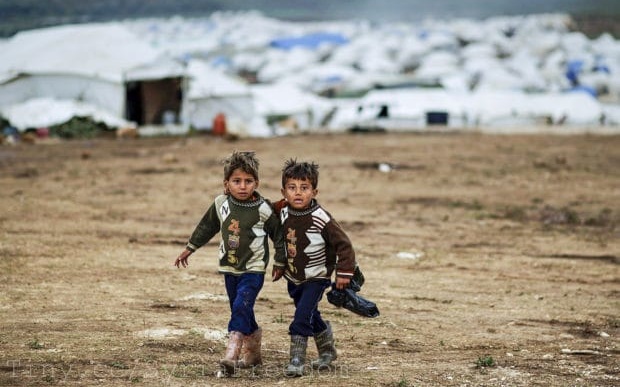Children in the Rukban camp for displaced Syrians near the Jordanian border (File)
Thousands of displaced Syrians continue to hold out in the besieged Rukban camp against the exhaustion of food, medicine, and other vital supplies.
The camp, near a barren area near the Jordan border, once had more than 50,000 residents. The Jordan-based Syrian policy group Etana says the number is down to 11,000, almost a year after Assad regime forces cut off the main route. Local sources report that the population could be as low as 6,500.
But those remaining say the fear of detentions, forced conscription, and harassment by regime personnel, as well as uncertainty over status of property, is blocking a return.
“We will stay until the last breath because we fear what awaits us if we return to the regime,” said Shukri Shehab, a local camp official.
The displaced fled home areas in Homs Province from 2015 amid Islamic State attacks.
Embarrassed by the tens of thousands who would not support its “reconciliation” narrative, the regime imposed the siege last September, preventing Bedouin traders from bringing in goods.
The UN aid agency OCHA says, “Efforts to provide assistance…are taking place.” But the agency has effectively made itself a hostage of the regime, saying it is awaiting permission from Damascus for any delivery.
The regime has allowed two convoys since January 2018.
Residents and activists reported this spring that bread and flour are close to exhaustion, forcing a diet of lentil soup. Prices for vegetables and oil soared. Many women could no longer breast-feed infants, and baby formula was absent.
There are no medical facilities except for rudimentary clinics, staffed by nurses and short of basic medicines and supplies. The seriously ill or pregnant have to hope for an emergency evacuation to Jordan.
“We’re living here on the cusp of death — conditions in Rukban are worse than zero,” said the head of one family.
Syria Daily, June 25: “The Cusp of Death” — No Bread or Flour in Besieged Rukban Camp
The siege is compounded by Jordan’s closure of the border since a June 2016 Islamic State suicide bombing, and by the US military’s refusal to provide aid, even though the camp is within a 55-km (34-mile) security zone around the American base at Tanf on the Iraq and Jordan borders.
“The situation is very, very bad and food supplies are not available,” says Mahmoud al Humeili, a leader in the camp.
Russia’s Propaganda, US Inaction
The Russian military is continuing its propaganda campaign, declaring its “humanitarian corridors” — rejected by the residents early this year, until the risk of starvation and death became too great — and insisting that “militants” and the US are to blame for the camp’s plight.
But American officials have played into Moscow’s hands by their rejection of the displaced, even while recruiting men from the camp as a local force against ISIS.
“If we feed them, it will look like we are going to stay there forever,” James Jeffrey, the US special representative for Syria, told an audience in Aspen, Colorado on July 19.
A women from the camp sent out a video message:
I am speaking to you from Rukban Camp, the camp of death and the camp of hunger.
I am pleading with every human who has a conscience to find a solution to this camp….
Our kids are dying in front of us and we are unable to do anything about it.
The deputy commander of the US-led coalition in Syria, Maj. Gen. Alex Grynkewich, blamed the Assad regime’s siege: “We have been consistent in calling on all parties to encourage the appropriate authorities to allow the UN unfettered access to Rukban in order to provide relief to the population there.”
A “senior administration official” passed blame to the US Agency for International Development, saying it has “refused to certify the need” at Rukban because it does not have access to the camp. But a USAID official said Washington is “pursuing every possible avenue to deliver aid to Rukban….Any assertion to the contrary is completely incorrect.”

